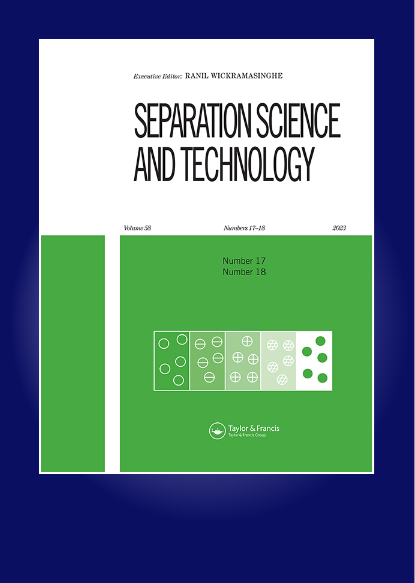矿物吸附剂(CSAM)与离子交换树脂去除电镀废水中镍(II)的比较研究
IF 2.3
4区 工程技术
Q3 CHEMISTRY, MULTIDISCIPLINARY
引用次数: 1
摘要
电镀废水中Ni(II)的去除效率与不同的吸附材料密切相关。比较了钙硅活性矿物吸附剂(CSAM)和两种离子交换树脂(732和D152)的吸附性能。三种材料对Ni(II)的吸附均为自发吸热吸附,其吸附量相近(318K时为48.66 ~ 65.36 mg/g),但CSAM用量较少(50 mg/L时为1.0 g/L),吸附速度较快(98.4%),同时还能有效去除Cu(II)(>98%)、总铬(>79%)和COD(>66%)。离子交换树脂处理含Ni(II)电镀废水受络合剂的影响较大。CSAM更适合于处理含多种金属和有机物的电镀废水。本文章由计算机程序翻译,如有差异,请以英文原文为准。
Comparative investigation on Ni(II) removal from electroplating wastewater by mineral adsorbent (CSAM) and ion-exchange resins
ABSTRACT The efficiency of Ni(II) removal from electroplating wastewater is highly correlated with different adsorption materials. A Ca-Si activated mineral adsorbent (CSAM) and two ion-exchange resins (732 and D152) were compared. The adsorption of Ni (II) by three materials is spontaneous and endothermic, and their adsorption capacities are similar (48.66–65.36 mg/g at 318K), but the dosage of CSAM is less (1.0 g/L for 50 mg/L Ni(II)), its adsorption is faster (<5 min) and pH range is wider (2–7). 10% NaCl, 1 mol/L HCl and 10% NaCl +1 mol/L HCl were used as desorbent agents, and CSAM exhibited an extremely low desorption rate (1.49–3.41%). The smaller separation factor (close to 0) and XPS analysis showed that the Ni(II) adsorption on CSAM was an irreversible chemical process, which was different from the three-stage adsorption of resins. The treatment of two kinds of electroplating wastewater with high and low concentration showed that CSAM not only had a higher Ni(II) removal rates (>98.4%), but also could efficiently remove Cu(II) (>98%), total-chromium (>79%) and COD (>66%). The treatment of Ni(II) containing electroplating wastewater with ion-exchange resins is greatly affected by the complexing agent. CSAM is more suitable for the treatment of electroplating wastewater containing various metals and organic matters.
求助全文
通过发布文献求助,成功后即可免费获取论文全文。
去求助
来源期刊

Separation Science and Technology
工程技术-工程:化工
CiteScore
6.10
自引率
3.60%
发文量
131
审稿时长
5.7 months
期刊介绍:
This international journal deals with fundamental and applied aspects of separation processes related to a number of fields. A wide range of topics are covered in the journal including adsorption, membranes, extraction, distillation, absorption, centrifugation, crystallization, precipitation, reactive separations, hybrid processes, continuous separations, carbon capture, flocculation and magnetic separations. The journal focuses on state of the art preparative separations and theoretical contributions to the field of separation science. Applications include environmental, energy, water, and biotechnology. The journal does not publish analytical separation papers unless they contain new fundamental contributions to the field of separation science.
 求助内容:
求助内容: 应助结果提醒方式:
应助结果提醒方式:


